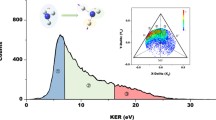Abstract
Operation and performance of an apparatus for studying the decay dynamics relevant to core–hole decay processes in atoms and molecules excited by energetic electrons using an energy analysed electron–ion coincidence technique are described in some detail. The setup consists of a time- and position sensitive double-field linear TOF mass spectrometer coupled with a dual MCP detector and a single-pass CMA to select the energy of detected electrons. Details of different components involved in the setup are presented and discussed. To demonstrate the performance and capability of the apparatus, we present some typical results extracted from the TOF argon ion-mass spectra observed in coincidence with 18-energy selected electrons emitted from interaction of a continuous beam of 3.5 keV electrons with a dilute gaseous target of argon atoms. Specifically, the variation of relative correlation probability for the final ion-charge states Ar1+ to Ar4+ produced in the considered collision reactions as a function of energy of emitted electrons is determined and discussed.








Similar content being viewed by others
References
M O Krause and T A Carlson Phys. Rev. 158 18 (1967)
T Tonuma et al. J. Phys. B At. Mol. Phys. 20 L31 (1987)
Y Tamenori et al. J. Phys. B At. Mol. Phys. 35 2799 (2002)
N Saito and I H Suzuki J. Phys. B At. Mol. Phys. 25 1785 (1992)
T A Carlson, W E Hunt and M O Krause Phys. Rev. 151 41 (1966)
B Adamczyk J. Chem. Phys. 44 4640 (1966)
M J van der Wiel, T M El-Sherbini and L. Vriens Physica 42 411 (1969)
S Okudaira, Y Kaneko and I Kanomata J. Phys. Soc. Japan 28 1536 (1970)
T M El-Sherbini, M J Van der Wiel and F J de Heer Physica 48 157 (1970)
R K Singh and R Shanker J. Phys. B At. Mol. Phys. 36 1545 (2003)
S Mondal and R Shanker Phys. Rev. A 72 052705 (2005)
R G Hayes and W Eberhardt Phys. Scr. 41 449 (1990)
D Céolin, C Miron, M Simon and P Morin J. Electron Spectrosc. Relat. Phenom. 141 171 (2004)
W Eberhardt, E W Plummer, I W Lyo, R Carr and W K Ford Phys. Rev. Lett. 58 207 (1987)
H Murakami, K Nagaya, Y Ohmasa, H Iwayama and M Yao J. Chem. Phys. 126 054306 (2007)
K Saha, S B Banerjee and B Bapat Rev. Sci. Instrum. 84 073101 (2013)
U Alkemper, R Hörnig and F von Busch J. Phys. B At. Mol. Phys. 29 35 (1996)
G Alberti, E Fainelli, F Maracci, M Mastropietro, R Platania and L Avaldi Rev. Sci. Instrum. 76 073101 (2005)
K Bučar and M Žitnik Radiat. Phys. Chem. 76 487 (2007)
E Fainelli, F Maracci, R Platania and L Avaldi J. Chem. Phys. 104 3227 (1996)
E Fainelli, F Maracci and L Avaldi J. Electron Spectrosc. Relat. Phenom. 123 277 (2002)
E Fainelli et al. J. Electron Spectrosc. Relat. Phenom. 161 51 (2007)
R Flammini, M Satta, E Fainelli, G Alberti, F Maracci and L Avaldi New J. Phys. 11 083006 (2009)
S Kumar, P Bhatt, B K Singh, A Kumar and R Shanker Int. J. Mass Spectrom. 385 32 (2015)
W C Wiley and I H McLaren Rev. Sci. Instrum. 26 1150 (1955)
CoboldPC, RoentDek Handels GmbH www.roentdek.com/software/software/
D Manura, D Dahl, Simion 8.0, D. Manura and D. Dahl, Technical Report: User Manual http://simion.com/manual/
L O Werme, T Bergmark and K Siegbahn Phys. Scrip. 8 149 (1973)
Acknowledgements
The authors would like to express their gratitude to the Department of Science and Technology (DST), New Delhi, Government of India for partial support through Grant No. SR/S2/LOP-033/2012 to carry out the experiments presented here. A significant part of the development of the experimental set up has been executed under support from the board of research in fusion science and technology (BRFST), Institute for plasma research (IPR), Ahmedabad, through the Grant No. NFP-DIAG-F10-01/2010, Department of Atomic Energy (DAE), Government of India. We are thankful to Pragya Bhatt, Raj Singh and Namita Yadav who have rendered their continuous support and help in the initial phase of development of the employed experimental setup.
Author information
Authors and Affiliations
Corresponding author
Rights and permissions
About this article
Cite this article
Kumar, S., Prajapati, S., Singh, B. et al. An experimental setup for studying the core-excited atoms and molecules by electron impact using energy analysed electron–ion coincidence technique. Indian J Phys 91, 721–729 (2017). https://doi.org/10.1007/s12648-017-0973-7
Received:
Accepted:
Published:
Issue Date:
DOI: https://doi.org/10.1007/s12648-017-0973-7
Keywords
- Core–hole decay processes
- TOF mass spectrometer
- Relative correlation probability
- Energy selected electron–ion coincidence technique




